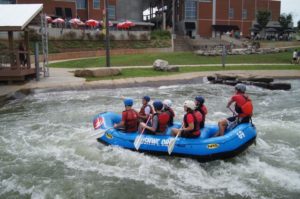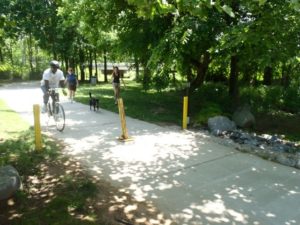I wrote the following for the Charlotte Observer, where it appeared Aug. 20, 2013. It appears here with links. A report on Raleigh’s ranking ran in this spot on Tuesday, Aug. 20.

According to the American College of Sports Medicine, Charlotte wheezes in at No. 36 in the recent fittest ranking of the nation’s 50 largest metro areas. (Raleigh trotted in far better at No. 15.)
The American Fitness Index, introduced in 2007, ranks cities in 30 categories ranging from acres of parkland and number of farmers markets, to number of smokers and people with heart disease, to the percentage of residents with health insurance.
On the newest ranking, released in May, Charlotte was cited as lacking in 19 of the 30 categories. Compared to the nation as a whole, it’s got an excessive number of smokers and obese residents, a higher number of residents with diabetes and heart disease and not enough primary health care providers.
It’s also lacking in playgrounds, dog parks, ball fields, rec centers, swimming pools and tennis courts, according to the index.
On the plus side, it has more farmers markets and acres of parkland per capita and fewer people who die from diabetes. The area evaluated was the Charlotte-Gastonia-Rock Hill Metropolitan Statistical Area.
The findings didn’t surprise Hall Rubin, who moved to the area three years ago. Rubin previously lived in the Triangle, where he founded and headed a 400-member Meetup group that hiked, biked and paddled three or four times a week.
“There are opportunities in Charlotte,” says the semi-retired Rubin, “but you really have to look for them.”
For instance, he says, “There are a few long, linear greenways in Charlotte, but they aren’t connected. You have to put your bike on the car and drive to them.”
Ken Tippette, the manager of the Bicycle Program for Charlotte’s Department of Transportation says it’s no surprise Charlotte took a hit in the ranking for having a low percentage of residents who bike or walk to work. Years of planning have conspired against residents making short commutes by bike or foot.
But Tippette says efforts are underway to change the situation.
The city is planning the Cross-Charlotte Trail, a nonmotorized passage that would run 26 miles, from Pineville on the south side of town to UNC Charlotte.
The $35 million project is expected to take 10 years to complete. He adds that the city has come a long way in a decade: In 2003, Charlotte had 1 mile of marked bike lane; today it has 75 miles and another 44 miles of greenways.
And the city’s new B-Cycle program that lets people rent and ride bicycles parked in uptown Charlotte and other sites just turned a year old. Nearly 500 annual memberships exceeded the program’s expectations by 40 percent, and the more than 11,000 one-day riders surpassed expectations by a whopping 1,600 percent, program officials said. The bikes have made 32,000 trips in a year.
And, there’s the Carolina Thread Trail, an effort to build a trail network in 15 counties linking 2.3 million people.
Charlotte’s presence in the heart of tobacco country also weighed against the region. Nearly 19 percent of residents smoke, about 6 percent above the national average.

N.C. Prevention Partners, a nonprofit that works to reduce early death from preventable illness, says the tobacco situation is gradually improving.
A growing number of tobacco-free facilities – public schools, acute care hospitals and restaurants among them – is helping to discourage smoking. The nonprofit continues to push for a $1 increase in the state cigarette tax, which it believes would keep more than 89,000 children a year from taking up smoking.
Charlotte also struck out for having an overweight population: 27.8 percent of residents qualify as obese, compared with the national average of 21.3 percent.
N.C. Prevention Partners isn’t quite as optimistic on the obesity front, noting that statewide, the figures are even higher: 2 of 3 Tar Heel adults are overweight or obese, while 28 percent of high school students are likewise.
“For the first time in 200 years, today’s generation might not live as long as their parents,” the nonprofit notes on its website.
Tippette, the Charlotte Bicycle Program manager, says the American Fitness Index also fails to take into account the new bike share program – Charlotte B-cycle – launched last year, or the fact that an increasing number of commuters are using their bikes and the city’s Lynx light rail system to get to work.
Says Tippette, “You can hardly ride the train and not see a person with a bike on it.”
Good article. I read it in the paper. Are you aware that McAlpine Greenway Park will be closed for 2 years to construct a new sewer line? Worse yet, it will be rebuilt with an asphalt surface. McAlpine Greenway by far the best place to run in Charlotte, mainly because of the pit gravel surface. Most runners in Charlotte are aware of it and run or have run at McAlpine. A city that is not considered to have enough parks shouldn’t be down grading one of the best parks that it has.